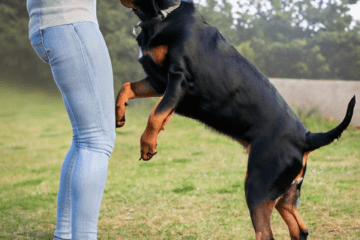 I have just been to the most stunning puppy. A four-month-old Leonberger called Amra.
I have just been to the most stunning puppy. A four-month-old Leonberger called Amra.
What was troubling the couple was their large puppy’s painful biting and pawing, particularly directed at the lady when she comes home. The gentleman initially referred to this as ‘dominance challenge’.
It’s easy to explain behaviour where the dog seems to be controlling us as ‘dominance’. This is now an outdated, unhelpful notion that leads to a confrontational training approach which, with a spirited dog, can eventually make for defiance – even aggression.
This beautiful dog fortunately has a lovely gentle nature and merely gets too excited. He then can’t control himself. He’s just a puppy being a puppy, but being the size he is makes biting and pawing, something he’s quite persistent with, painful.
What is behind the behaviour isn’t dominance – the puppy wanting to become Alpha – but that certain behaviours bring him the most reinforcement. When he gets a bit rough he can bank on getting rewarded in terms of attention of some sort. A confident dog and kindly treated dog isn’t at all upset by being told NO. The word may stop him in his tracks, but does it teach him anything positive?
Amra’s ‘silly’ times can be anticipated. They can pre-empt the puppy wildness with various occupations that keep him busy including hunting and chewing.
With each thing they want to change (and there are very few), we can analyse just what happens immediately afterwards – realising that it’s the rewarding consequence that is driving a behaviour to repeatedly occur. Sometimes what that consequence actually is needs searching for.
Here is an example. When the lady comes home from work (the gentleman works from home), Amra gets very excited indeed. The manner of her arrival and their greeting helps to trigger a mad and rough half hour. The pup will grab her leg. What happens now is that the gentleman calls him away and then distracts him – maybe plays with him. The dog’s reward could be that he indirectly gets quality reaction from the man.
I suggest, if they’ve not successfully managed the situation by setting things up differently in advance, that the gentleman experiments with simply walking out of the room and shutting the door as soon as the dog grabs the lady (and that she wears tough jeans for a week or two)! If that doesn’t work, what Amra is ‘getting out of it’ needs to be re-examined as will the things that lead up to it.
I always love going to a puppy that has been to some formal old-fashioned type of training based on ‘commands’ and ‘control’ and to introduce both people and dog to the notion of using Yes instead of No – constantly reinforcing desired behaviour and having the puppy wanting to please rather than simply being expected to comply.
This same principal applies to when walking Amra on lead. They already have him walking around the house and garden beside them off lead, but once the lead goes on he’s pulling down the road. It’s so easy to have a puppy walking nicely if one has appropriate, comfortable equipment and a different mind-set.
Because Amra will grow to be so large, from the start they have been doing everything they can to make sure he grows up to be a gentle and well-mannered adult dog.



